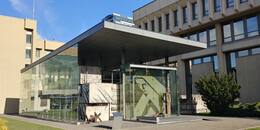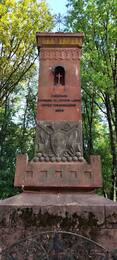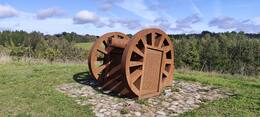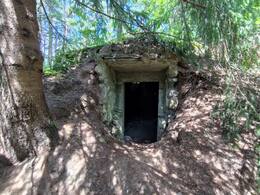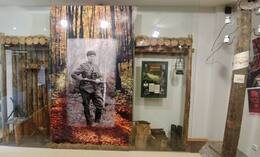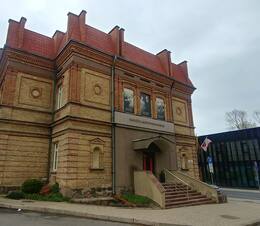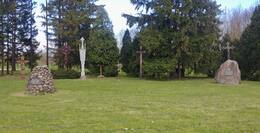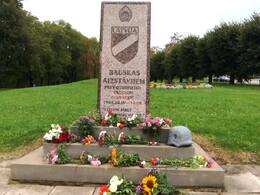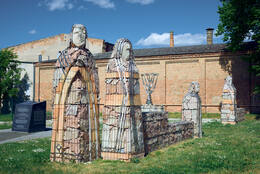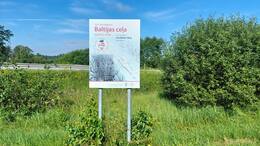Along the Baltic Way from Vilnius to Riga
January 13th Memorial of the Seimas of the Republic of Lithuania
The monument is located in Vilnius, in front of the Second Palace of the Parliament (Seimas) of the Republic of Lithuania. In January 1991, the people of Lithuania surrounded the Par liament Palace with barricades, in a fight for and in defence of their freedom. It was an attempt to protect Lithuania from military aggression by the Soviet Union of the time – Soviet at tempts to stage a coup d’état in Lithuania and restore Soviet rule. Barricades surrounded the Parliament building until the end of 1992. In 1993, in front of the Palace of the Seimas of the Republic of Lithuania, a unique memorial was erected – made of parts of the barricades and other relics – it was dedicated to the Lithuanian people who sacrificed their lives for freedom. On 13 January 1991, tragic events unfolded, as the Soviet Army and special forces occupied the Lithuanian Radio and Televi sion Centre building and the television tower, killing 14 freedom fighters and injuring around 600 people. As the tenth anniversary of the Defenders of Freedom Day was approaching, a decision was made to preserve the composition by creating a memorial to 13 January. The Memorial was inaugurated in 2008. The memorial preserves an authentic fragment of the 1991 par liamentary barricades and has a chapel with an icon to the Blessed Virgin Mary. The memorial displays objects brought by people and provides an insight into the events that took place during the defence of the independence of Lithuania.
Monument to the Soldiers Killed for Lithuania‘s Freedom in 1920
The monument is located in Giedraičiai.
On 19 June 1932, a monument dedicated to the fallen Lithuanian freedom fighters was unveiled in Giedraičiai. The construction of the monument was initiated by the inhabitants of Giedraičiai – the painter and author of the monument Antanas Jaroševičius, Pastor Meigis, Malvina Valeikienė and Matas Valeika, who sup ported the Lithuanian soldiers in battle, the community of Širvintos and the Lithuanian Army; the amount of 11,000 litas was raised for the construction of the monument. The appeal for donations for the monument states that it is being built “to honour victory and our eternal joy, which will remind us of the historical significance of the site and pay tribute to the soldiers buried in Giedraičiai”. The opening ceremony was sumptuous. It was attended by the President of the Republic of Lithuania, A. Smetona – Command er-in-Chief of the Lithuanian Armed Forces, representatives of the 2nd, 4th, 7th, and 9th Regiments and officers, who took part in the Battles of Giedraičiai. Flowers were dropped at the monument from military planes, and Malvina Valeikienė, a prominent Lithu anian personality and one of the organisers of the construction works of the monument, read out the names of the Lithuanian soldiers who died in Giedraičiai, and she was awarded the Order of the Cross of the Knight, 3rd Class. The flag of the local rifle men unit was consecrated at the monument. From 1962–1964, pursuant to the instructions of the Soviet administration, an un successful attempt was made to demolish the monument, but it was later declared a historical monument.
A stylised cannon commemorating the 100th anniversary of the Battle of Giedraičiai
A stylised cannon commemorating the 100th anniversary of the Battle of Giedraičiai is located behind the town of Giedraičiai, 200 m after turning off on road No. 172.
On 21 November 2020, a monument by sculptor Džiugas Jurkūnas was unveiled on a hill at the site of the Battle of Giedraičiai, commemorating the victory. The monument is a stylised interpretation of the battles of the Lithuanian Army against the Polish Army during the inter-war period. In an attempt to move away from the description of the conflict, the monument highlights the importance of the union of the two countries in the context of contemporary events. The rust-covered cannon symbolises the strong union of the re publics of Lithuania and Poland – two countries that fought each other a century before. The situation of the time is described on the sides of the monument; the Lithuanian and Polish Army units involved are mentioned and a brief description of the battle is provided. The Lithuanian Armed Forces are the initiator and the funder of the erection of the monument
Eastern Lithuania (King Mindaugas) region Lithuanian partisan command post
After driving past Andrioniškis Cemetery (there is a signpost), there is a preserved hideout – a command post. From 1944– 1949, a command post of the Lithuanian partisans of the Eastern Lithuania (King Mindaugas) region operated in this hiding place. In the summer of 1944, Balys Žukauskas, with brothers Petras and Juozas Jovaišos, established the hiding place to evade the mobilisation announced by the Red Army in 1944. At the end of 1945, Antanas Slučka-Šarūnas started to use the hiding place. He was the first one to form a partisan unit in the Troškūnai area and later united the partisans of Rokiškis, Anykščiai, Kavarskas, Troškūnai, and Andrioniškis to form the Šarūnas Unit. In 1947, A. SlučkaŠarūnas became the commander of the Algimantas district, and in 1949 – the commander of the Eastern Lithuania partisan region. This means that from 1949, the hiding place became the command post of the Lithuanian partisans in the Eastern Lithuania region. The hiding place, which had successfully sheltered partisans for five years, was betrayed on 28 October 1949. The farm where the partisans were hiding was besieged by KGB troops; the partisans refused to surrender and blew themselves up.
The bunker has been preserved, and a cross and a monument to the fallen have been installed.
Monument dedicated to Algimantas Military District partisans
The monument is located in the centre of Troškūnai, Anykščiai district, near the Church of Holy Trinity. During the partisan war of 1944–1953, the territory of Lithuania was divided into nine partisan military regions. From 1947–1950, partisan units of the Algimantas region of Lithuania, the establishment of which is closely related to Troškūnai, were active in the Panevėžys and Anykščiai area. The inhabitants of this town organised partisan units in Aukštaitija. The first partisan commander of the Algimantas region, Antanas Slučka-Šarūnas, was born and lived in Troškūnai.
In 1996, pursuant to the initiative of the Genocide and Resistance Research Centre of Lithuania, a monument dedicated to the partisans of the Algimantas Military District was erected in Troškūnai. The monument was created by sculptor Jonas Jagėla and architect Audronė Kiaušinienė. The main part of the monument is a black stone gate that symbolises the fallen defenders of the homeland. The bronze crosses on the sides of the gate symbolise the Christian faith, while the bronze sword, like the sword of St Michael the Archangel, symbolises the light of faith and hope. In the square in front of the monument, a black stone plaque commemorates the three units of the Algimantas region: Šarūnas, Žalioji and Kunigaikštis Márgiris.
Exposition on the Resistance to Soviet Occupation and Sąjūdis at the Panevėžys Local Lore Museum
The exposition is located in an authentic place – the premises of the Panevėžys group of the Lithuanian reform movement “Sąjūdis”. The Sąjūdis of Panevėžys has been operating here since October 1988.
In 2004, an exposition on the resistance to the Soviet occupation and an exhibition dedicated to the “Sąjūdis” were opened in the building. The exposition reveals the extent and forms of popular resistance starting from 15 June 1940 to 11 March 1990, and introduces the most importantstages and events of the anti-Soviet movement, as well as Soviet repressions.
Expositions “Okupacijų gniaužtuose” (“In Squeeze of Occupations”) and “Raudonasis teroras” (“Red Terror”) at the Panevėžys Local Lore Museum
The expositions are located in downtown Panevėžys. The Soviets confiscated the house, built at the end of the 19th century for the rominent Moigiai family of Panevėžys. From 1940–1941 it housed the headquarters of the Soviet military unit, the interrogation department of the NKGB (People’s Commissariat for State Security) of Panevėžys District and the militia. From 1944 to 1953 it was the headquarters of the Panevėžys County NKGB-MOI-KGB. It is now the premises of the Panevėžys Local Lore Museum.
The Exposition “Okupacijų gniaužtuose” (“In the Squeeze of Occupations”) presents the Nazi and Soviet occupations. It introduces the themes of the Jewish and Roma genocide, deportations and the themes of partisan war. The part of the exhibition devoted to the years 1953–1990 tells the story of everyday life in Khrushchevka, the efforts of the Soviet government to create a Soviet society, the resistance of people to this violence, and the activities of the underground. You can hear recordings of radio broadcasts from abroad, secretly listened to by the people of the time, with radio interference caused by the Soviet authorities.
The exhibition “Raudonasis teroras” (“Red Terror”) is dedicated to the memory of the victims who were killed in the basement of this house, shot at the Panevėžys sugar factory, as well as the history of the crimes committed by the Soviet occupation regime. The hopes of free people and the destruction thereof under Soviet rule are allegorically depicted in time and space – the interior of the apartment of the merciful Sister Zinaida Kanis-Kanevičienė at the time of the independent Lithuania, who was tortured to death, and a replica of the interrogation room of the NKGB.
“Įstra” Aviation Museum
The museum is located 10 km from Panevėžys, on the left side of the Panevėžys-Pasvalys road (A10; section E67 of Via Baltica) (an informative road sign has been installed).
The museum was established in 2016, inspired by the aviator and aviation enthusiast Virmantas Puidokas, and is located on the grounds of the Įstra airfield. The airfield dates back to 1984 when planes took off from the airfield to spread fertilisers or other chemicals on the agricultural fields. The museum has an open-air and indoor exhibition. The open-air exhibition features Soviet-era Su-15, MiG-21 and MiG-23 fighters, Mi-2 and Mi-8 helicopters, as well as -29 military trainer aircraft built in Czechoslovakia (all aircraft were built in the 1960s and 1970s). Indoor exhibitions introduce the history of aviation in the world and in Lithuania, as well as military aviation equipment, devices and paraphernalia of World War I, World War II and the Cold War. A collection of military pilot equipment, rescue, communication, audio recording and other equipment from different countries is on display, as well as a collection of daggers from the parade uniforms of Air Force officers.
Cross Valley to Commemorate the Baltic Way
The Cross Valley to Commemorate the Baltic Way memorial is located on the eastern outskirts of Pasvalys on the Via Baltica motorway (E67, A10).
On 23 August 1989, to commemorate the occasion of the 50th anniversary of the signing of the criminal Molotov-Ribbentrop Pact and its secret protocol, based on the initiative of the Lithuanian reform movement “Sąjūdis”, the Latvian People’s Front and the Estonian People’s Front, a live human chain linked the capitals of the three Baltic states – Vilnius, Riga and Tallinn. Holding hands, approximately two million people joined together in a living chain that was about 650 km long. This chain, known as the Baltic Way, is one of the most remarkable and memorable events on the road to independence of the countries occupied
by the Soviets.
To commemorate this event, memorial signs have been erected along the Baltic Way route (Vilnius-Ukmergė-Panevėžys- Pasvalys-Saločiai). The Cross Valley to Commemorate the Baltic Way is one of the monuments dedicated to this memorial route. The history of Cross Valley began on the eve of the Baltic Way when the residents of Pasvalys started using boulders to build the Altar of Freedom. On 23 August, the crosses were installed in the valley by the participants of the Baltic Way from Pasvalys, Akmene, Joniškis, Kretinga, Mosėdis, and Pakruojis. Later, crosses were erected to commemorate important events and
people of note, as well as crosses dedicated to the friendly Norwegian and Swedish people.
Monument to the defenders of Bauska against the Soviet occupation in 1944 in the Castle Garden
The monument to the defenders of Bauska in 1944 was unveiled on September 14, 2012, at the initiative of former Bauska Volunteer Battalion soldier Imants Zeltiņš and with his and the local government's financial support. The red granite stele, which is mounted on a three-tiered concrete base, is engraved with the text: “To the defenders of Bauska against the second Soviet occupation 1944.28.07.-14.09.” and “Latvia must be a Latvian state. Kārlis Ulmanis.” The unveiling of the monument was followed by protests from the Russian and Belarusian Foreign Ministries and local Russian mass media, but in the spring of 2024 the monument was even attacked by vandals. Despite this, a memorial event dedicated to the defenders of Bauska is held at this location every year on September 14 at 2:00 p.m.
At the end of July 1944, as the Soviet troops approached Bauska, there were no significant German forces in the city, which had recently been deep in the rear. The immediate fall of Bauska was prevented by the decisive action of Major Jānis Uļuks, the head of the Bauska district and commander of the guard regiment, who at the end of July formed the Bauska Volunteer Battalion, which consisted of guards of the 13th Bauska Guard Regiment, police officers, as well as volunteers. The battalion took up defensive positions on the banks of the Lielupe River in Jumpravmuiža opposite the Ziedoņi islet and on the first day it had to engage in battle with the attacking Red Army. Initially, the battalion was very poorly armed, and most of its automatic weapons had to be obtained as trophies. A few days later, the 23rd, 319th-F. and 322nd-F. Latvian police battalions also joined the war effort. Until mid-August, the 15th Latvian SS Reserve and Supplement Brigade Battalion, formed from training and medical companies, also participated in the defense of Bauska against the second Soviet occupation. In total, 3,000-4,000 Latvian soldiers participated in the battles for Bauska, who at the end of the battles had to face a tenfold superiority. Soviet troops managed to take Bauska only on September 14, after a month and a half of resistance by Latvian and German soldiers.
Memorial ensemble for those who fought against the Soviet occupation and the victims of communist repression in the Bauska Castle Garden
The memorial ensemble in the Bauska Castle Garden was opened on the 90th anniversary of the Republic of Latvia – on November 18, 2008. The memorial site was created according to the idea of the Bauska region’s politically repressed club “Rēta”. The two-part grey granite monument was made according to the design of architect Inta Vanaga with the funds of the Bauska city municipality and donors. The text is engraved on it: “To the fighters against the Soviet occupation regime, those arrested, deported and tortured 1940-1990”. Every year on March 25 and June 14, memorial events dedicated to the victims of the deportations of 1941 and 1949 are held at this place
Memorial "Synagogue Garden"
The memorial is located in the city centre, not far from the Bauska Municipality Tourist Information Centre and Town Hall Square.
It was created thanks to the initiative and donations of the descendants of Bauska Jews living in Israel, the USA and Great Britain, as well as the support of the Bauska Municipality Council and Latvian Jewish congregations and communities.
The memorial was designed by sculptor Ģirts Burvis. It is the same size as the former Bauska Great Synagogue, and the stone images symbolise Jews coming out of the place of worship after the service. A symbolic bimah is situated in the centre of the memorial; it is a raised platform or table used in Jewish religious rituals in the synagogue. An inscription on it reads: “A tribute to the Jews of Bauska, who lived here for centuries and built this city, and who were killed by the Nazis and their local helpers in 1941. Honouring the memory of the Jewish people – the descendants of the Jews of Bauska and the people of Bauska.”
In 1935, almost 800 Jews lived in Bauska. After the Nazi occupation, in July 1941, many Jews were arrested and deported, and around 700 Jews were shot. Bauska Great Synagogue was destroyed during World War II.
Freedom Monument in Iecava
The Freedom Monument in Iecava, carved in stone by Pēteris Banders in 1936, is located in Iecava Park on the bank of the River Iecava valley.
The idea of the monument was initiated by Jānis Lūsis, pastor of Iecava-Lambārte Parish, and a participant of the Latvian War of Independence. The monument is dedicated to the soldiers of the 4th Valmiera Infantry Regiment who fell in the vicinity of Iecava, and to the Latvian soldiers who lost their lives in the Latvian War of Independence. During the Soviet occupation, the monument was blown up, however, it was not destroyed and was eventually restored in 1988. In 2018, the monument was included on the List of State Protected Cultural Monuments.
On 11 November 2018, a commemorative plaque for five recipients of the Order of Lāčplēsis who were born in the former Iecava Region, was unveiled in Iecava Park. General Werners Tepfers, Lieutenant Colonel Jēkabs Jurševskis, Captains Nikolajs Pļavnieks and Herberts Tepfers, and Corporal Jēkabs Klauss were honoured. The granite statue was created as part of the project “Atceries Lāčplēšus” (Remember the Bearslayers) to commemorate the soldiers who fell in the Latvian War of Independence.
Commemorative sign dedicated to the 25th anniversary of the Baltic Way
During the campaign “Baltic Road” on August 23, 1989, people from Kurzeme and Zemgale - Liepāja, Saldus, Dobele, Kuldīga, Ventspils, Talsi, Tukums and their surroundings arrived on the Riga - Bauska highway section. The main task was to achieve the most even distribution of people and continuity of the chain. Where there was not enough arm length, people were asked to use flags, belts, or even jacket sleeves, just so that the blood circulation of community in this artery would not be interrupted. In total, about 400,000 Latvian residents participated in this campaign.
The memorial sign dedicated to the 25th anniversary of the Baltic Way in Ķekava municipality, at the 25th kilometer of the Riga-Bauskas highway near the Ķekaviņa River, was unveiled on August 23, 2014. Its ceremonial opening was attended by the Prime Minister of the Republic of Latvia, Laimdota Straujuma, a long-time employee of the State Joint-Stock Company “Latvijas Valsts ceļi” and a member of the Baltic Way, Uldis Birzleja, and other attendees. In 2014, 10 such memorial signs were erected on the Baltic Way section of Latvia in memory of this event. Four memorial signs were erected in Estonia, and nine in Lithuania. On July 30, 2009, the Baltic Way campaign was included in the UNESCO “Memory of the World” documentary heritage list.




